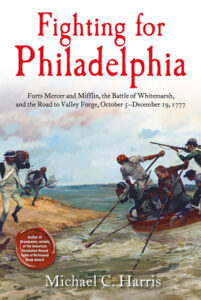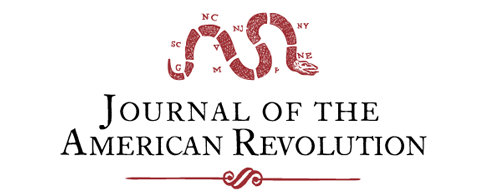BOOK REVIEW: Fighting for Philadelphia: Forts Mercer and Mifflin, the Battle of Whitemarsh, and the Road to Valley Forge, October 5-December 19, 1777 by Michael C. Harris (El Dorado Hills, CA: Savas Beatie, 2025)
When examining the 1777 Philadelphia campaign, historians often skip from the Battles of Brandywine and Germantown, in September and early October, straight to the winter at Valley Forge, overlooking the crucial events that took place in late 1777. In his new book, Michael C. Harris describes the land and naval battles between October and December 1777 that led to the British controlling the essential Delaware River supply route, which kept their army armed, fed, and clothed during the winter. Previously, the Philadelphia-area educator and public historian penned books about the battles of Brandywine and Germantown, as well as an overview of the entire Philadelphia campaign. Harris is also a contributor to the Journal of the American Revolution.
 Key indicators of an excellent historical account include balanced, comprehensive interpretations, fresh and original insights, and the debunking of myths that have become deeply ingrained in the historical record. Harris hits the mark on all three counts.
Key indicators of an excellent historical account include balanced, comprehensive interpretations, fresh and original insights, and the debunking of myths that have become deeply ingrained in the historical record. Harris hits the mark on all three counts.
The former National Park Service historian argues convincingly that, although the British defeated the Continental Army in two major battles and occupied Philadelphia, the campaign was not finished, and Rebel forces could still force the British to retreat and abandon Philadelphia. The Rebels held three forts guarding obstructions on the Delaware River, preventing the Royal Navy from resupplying Gen. William Howe’s expeditionary force. As a result, the British Army was dependent upon a tenuous and insufficient supply line stretching from the Royal Navy anchorage in Delaware Bay below Chester, Pennsylvania, to Philadelphia.
General George Washington recognized the opportunity to turn around Rebel prospects by denying the river passage and forcing the British in Philadelphia to starve or retreat (page 142-3). He ordered reinforcements to Fort Mifflin, on the west side of the river, and Fort Mercer on the east side. The author notes that Washington’s judgment led to the only Rebel victory of the Philadelphia campaign when the Fort Mercer garrison repelled a Hessian frontal assault, inflicting heavy casualties.
On the other hand, Harris criticizes Washington for not attempting to lift the later siege of Fort Mifflin. He believes that Washington relied too heavily on the Pennsylvania militia to flood the island, where British artillery batteries were pounding the fort from the west (p. 151). Also, Washington could have attacked the British artillery with Continentals from behind. Harris argues that it’s unclear why, given the importance of stopping Royal Navy supply ships from reaching Philadelphia, Washington did not view the situation himself and support the defenders of Fort Mifflin (p. 152). Without aid, the fort became hopeless to defend, and the garrison crossed the river to Fort Mercer, leaving the torn and tattered flag of the garrison flying. Like dominoes, Fort Mercer also became impossible to defend without support from its sister fort and was abandoned, opening the river supply route and securing the British position in Philadelphia. Harris provides a more realistic picture of Washington’s generalship by acknowledging both the positive and negative consequences of his command decisions.
Harris presents a fresh interpretation of the events surrounding the Battle of Whitemarsh. Traditionally, historians see General Howe’s motivations as luring Washington’s army into a general engagement to end the war. After the riverine forts fell, Washington positioned his forces on the Whitemarsh hills, twenty miles north and west of Philadelphia. It was a strong position defended by Washington’s largest army of the campaign. Howe moved out of Philadelphia with his forces toward Whitemarsh. Washington and later historians viewed the British general’s actions as another attempt to force a battle that would destroy the Continental Army.
Alternatively, Harris identifies that Howe brought many empty supply wagons and little food. These factors suggest a large-scale foraging mission to collect grain, hay, and cattle for the garrison, which was constantly facing shortages, rather than aiming for a major assault. When Howe encountered Washington blocking his path, he ordered the wagons to be sent back to Philadelphia for rations and supplies to prepare for a potentially advantageous battle. After assessing the situation, Howe concluded that a frontal attack was not feasible and attempted to outflank the Continental Army’s left side. Finding no easy way to bypass the extended Patriot lines, Howe withdrew to Philadelphia. The author’s analysis suggests that historians have underestimated British supply difficulties, leading them to misinterpret Howe’s motives and actions as purely offensive, rather than recognizing that his efforts were mainly foraging operations (p. 264, 303).
The third attribute of a good book is dispelling myths and correcting scholarship. Since his boyhood, Harris learned the story of Jonas Cattell, a patriot sympathizer who escaped from an assault force and allegedly sprinted ahead to warn Fort Mercer’s commander about the upcoming Hessian attack (p. 107-9). Several historians have supported Cattell’s heroic deeds. Because of this, the local Sons of the Revolution built a monument in Cattell’s honor, and an annual ten-mile race celebrates his bravery.
While inspiring, Harris thoroughly demonstrates that Cattell could not have escaped from the Hessians on the morning of the attack and run the ten miles to warn the Patriots. Harris researched Cattell’s pension records, which do not mention the daring escape and run, but indicate that he was within the fort on the morning of the attack and ordered to leave with the New Jersey militia to provide more room for the Rhode Island Continentals. It is telling that Cattell omitted any mention of a harrowing escape and dash, as pension seekers typically offered as much support as possible for their application. Despite demonstrating that Jonas Cattell’s warning was a myth, I hope the community continues to hold the race to commemorate the brutal battles around Fort Mercer.
In addition to its excellent historiography, the book possesses several attributes that make it enjoyable to read. The author begins with a Dramatis Personae to introduce the key British, Hessian, and American commanders, thereby enabling an uninterrupted narrative. Readership is further enhanced by a copious number of excellent maps depicting the armies’ movements. Data junkies will benefit from the appendices delineating the British, Hessian, and Rebel orders of battle and descriptions of naval fleets with associated armaments. Lastly, an unusually detailed index listing specific military units will be helpful to those interested in regimental histories.
My quibbles are few. The author interjects throughout the narrative descriptions of the purported plot among the generals to replace Washington as commander-in-chief, referred to by historians as the Conway Cabal. Named after the key conspirator and French volunteer Thomas Conway, the plot is complex and challenging to understand, potentially diverting or confusing readers without extensive knowledge of the officer corps’ intrigue. Indeed, the author makes a valid point that the ostensible coup consumed Washington’s attention, potentially hindering critical decisions. An ending summary of how the Conway Cabel either helped or hindered specific decisions made by Washington during the Philadelphia campaign would have better aided readers.
Looking at the big picture, the author effectively demonstrates why a new book on the well-documented Philadelphia campaign is necessary to gain a deeper understanding of its final months. The author offers new insights, including a balanced assessment of Washington’s decision-making, novel interpretations of Howe’s intentions and actions, and the replacement of myths with more substantiated accounts. Harris thoroughly supports his principal thesis that the Delaware River war was a critical factor in the outcome of the British campaign. Whether or not there was a realistic chance of the Rebels preventing British shipping from operating on the Delaware is a fascinating question. Along with other pivotal turning points of the Revolutionary War, it is intriguing to contemplate how close the British came to retreating from Philadelphia after defeating the Rebels in the two most significant battles of the campaign. As a result, readers will enjoy reflecting on Benjamin Franklin’s quote when asked about the British conquest of Philadelphia: “No, sir, Philadelphia has taken the British.”
PLEASE CONSIDER PURCHASING THIS BOOK FROM AMAZON IN HARDCOVER OR KINDLE.
(As an Amazon Associate, JAR earns from qualifying purchases. This helps toward providing our content free of charge.)





Recent Articles
New Jersey’s Revolutionary Rivalry
The Evolution of the American Declaration of Independence
The Deadliest Seconds of the War
Recent Comments
"The Evolution of the..."
This article is a gem. Sparkling. Excellent research. Wide and deep. Thank...
"The Evolution of the..."
A very interesting article, thank you! A more general question, if you...
"The Evolution of the..."
Thoroughly researched and a succinct presentation, especially given the article's breadth.